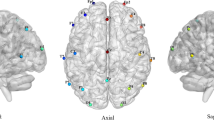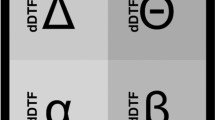Abstract
Deep learning techniques have recently made considerable advances in the field of artificial intelligence. These methodologies can assist psychologists in early diagnosis of mental disorders and preventing severe trauma. Major Depression Disorder (MDD) is a common and serious medical condition whose exact manifestations are not fully understood. So, early discovery of MDD patients helps to cure or limit the adverse effects. Electroencephalogram (EEG) is prominently used to study brain diseases such as MDD due to having high temporal resolution information, and being a noninvasive, inexpensive and portable method. This paper has proposed an EEG-based deep learning framework that automatically discriminates MDD patients from healthy controls. First, the relationships among EEG channels in the form of effective brain connectivity analysis are extracted by Generalized Partial Directed Coherence (GPDC) and Direct directed transfer function (dDTF) methods. A novel combination of sixteen connectivity methods (GPDC and dDTF in eight frequency bands) was used to construct an image for each individual. Finally, the constructed images of EEG signals are applied to the five different deep learning architectures. The first and second algorithms were based on one and two-dimensional convolutional neural network (1DCNN–2DCNN). The third method is based on long short-term memory (LSTM) model, while the fourth and fifth algorithms utilized a combination of CNN with LSTM model namely, 1DCNN-LSTM and 2DCNN-LSTM. The proposed deep learning architectures automatically learn patterns in the constructed image of the EEG signals. The efficiency of the proposed algorithms is evaluated on resting state EEG data obtained from 30 healthy subjects and 34 MDD patients. The experiments show that the 1DCNN-LSTM applied on constructed image of effective connectivity achieves best results with accuracy of 99.24% due to specific architecture which captures the presence of spatial and temporal relations in the brain connectivity. The proposed method as a diagnostic tool is able to help clinicians for diagnosing the MDD patients for early diagnosis and treatment.








Similar content being viewed by others
References
Acharya UR, Sudarshan VK, Adeli H, Santhosh J, Koh JE, Puthankatti SD, Adeli A (2015) A novel depression diagnosis index using nonlinear features in EEG signals. Eur Neurol 74(1–2):79–83. https://doi.org/10.1159/000438457
Acharya UR, Oh SL, Hagiwara Y, Tan JH, Adeli H (2018a) Deep convolutional neural network for the automated detection and diagnosis of seizure using EEG signals. Comput Biol Med 100:270–278
Acharya UR, Oh SL, Hagiwara Y, Tan JH, Adeli H, Subha DP (2018b) Automated EEG-based screening of depression using deep convolutional neural network. Comput Methods Programs Biomed 161:103–113
Afshani F, Shalbaf A, Shalbaf R, Sleigh J (2019) Frontal–temporal functional connectivity of EEG signal by standardized permutation mutual information during anesthesia. Cogn Neurodyn 13(6):531–540
Ahmadlou M, Adeli H, Adeli A (2012) Fractality analysis of the frontal brain in major depressive disorder. Int J Psychophysiol 85:206–211
Ahmadlou M, Adeli H, Adeli A (2013) Spatiotemporal analysis of relative convergence of EEGs reveals differences between brain dynamics of depressive women and men. Clin EEG Neurosci 44:175–181
Association AP (2000) Diagnostic and Statistical manual of mental disorders: DSM-IV-TR®. American Psychiatric Publishing, Washington, DC
Astolfi L, Cincotti F, Mattia D, Marciani MG (2007) Comparison of different cortical connectivity estimators for high-resolution EEG recordings. Hum Brain Mapp 28(2):143–157
Ay B, Yildirim O, Talo M, Baloglu UB, Aydin G, Puthankattil SD, Acharya UR (2019) Automated depression detection using deep representation and sequence learning with EEG signals. J Med Syst 43(7):205. https://doi.org/10.1007/s10916-019-1345-
Baccalá LA, Sameshima K (2001) Partial directed coherence: a new concept in neural structure determination. Biol Cybern 84:463–474
Baccalá LA, Sameshima K (2007) Generalized partial directed coherence. In: 15th International conference on digital signal processing, pp 163–166. IEEE
Bachmann M, Lass J, Hinrikus H (2017) Single channel EEG analysis for detection of depression. Biomed Signal Process Control 31:391–397
Chaudhary S, Taran S, Bajaj V, Sengur A (2019) Convolutional neural network-based approach towards motor imagery tasks EEG signals classification. IEEE Sens J 19(12):4494–4500
Chauhan R, Ghanshala KK, Joshi RC (2018) Convolutional neural network (CNN) for image detection and recognition. In: 2018 First international conference on secure cyber computing and communication (ICSCCC), Jalandhar, India, pp 278–282
Čukić M, Stokić M, Simić S, Pokrajac D (2020) The successful discrimination of depression from EEG could be attributed to proper feature extraction and not to a particular classification method. Cogn Neurodyn 14(4):443–455
Esteva A, Kuprel B, Novoa RA, Ko J, Swetter SM, Blau HM, Thrun S (2017) Dermatologist-level classification of skin cancer with deep neural networks. Nature 542(7639):115–118
Faust O, Ang PCA, Puthankattil SD, Joseph PK (2014) Depression diagnosis support system based on EEG signal entropies. J Mech Med Biol 14(3):1450035
Faust O, Hagiwara Y, Hong TJ, Lih OS, Acharya UR (2018) Deep learning for healthcare applications based on physiological signals: a review. Comput Methods Programs Biomed 161:1–3
Geweke JF (1984) Measures of conditional linear dependence and feedback between time series. J Am Stat Assoc 79(388):907–915
Granger CW (1969) Investigating causal relations by econometric models and cross-spectral methods. Econometrica 37:424–438
Hochreiter S (1998) The vanishing gradient problem during learning recurrent neural nets and problem solutions. Int J Uncertain Fuzziness Knowl Based Syst 6(02):107–116
Hochreiter S, Schmidhuber J (1997) Long short-term memory. Neural Comput 9:1735–1780
Hosseinifard B, Moradi MH, Rostami R (2013) classifying depression patients and normal subjects using machine learning techniques and nonlinear features from EEG signal. Comput Methods Programs Biomed 109:339–345
Kaminski M, Ding M, Truccolo WA, Bressler SL (2001) Evaluating causal relations in neural systems: Granger causality, directed transfer function and Statistical assessment of significance. Biol Cybern 85:145–157
Li X, Hu B, Sun S, Cai H (2016) EEG-based mild depressive detection using feature selection methods and classifiers. Comput Methods Programs Biomed 136:151–161
Litjens G, Kooi T, Bejnordi BE, Setio AAA, Ciompi F, Ghafoorian M, Sánchez CI (2017) A survey on deep learning in medical image analysis. Med Image Anal 42:60–88
Luan Y, Lin S (2019) Research on text classification based on CNN and LSTM. In: 2019 IEEE international conference on artificial intelligence and computer applications (ICAICA), pp 352–355. IEEE
Mullen T (2010) An electrophysiological information flow toolbox for EEGLAB theoretical handbook and user manual
Mumtaz W, Qayyum A (2019) A deep learning framework for automatic diagnosis of unipolar depression. Int J Med Inform 132:103983
Mumtaz W, Xia LK, Ali SSA, Yasin MAM, Hussain M, Malik AS (2017a) Electroencephalogram (EEG)-based computer-aided technique to diagnose major depressive disorder (MDD). Biomed Signal Process Control 31:108–115
Mumtaz W, Xia L, Mhod Yasin MA, Azhar Ali SS, Malik AS (2017b) A wavelet-based technique to predict treatment outcome for Major Depressive Disorder. PLoS ONE 12(2):e0171409. https://doi.org/10.1371/journal.pone
Nagabushanam P, George ST, Radha S (2019) EEG signal classification using LSTM and improved neural network algorithms. Soft Comput 24:9981–10003
Puthankattil SD, Joseph PK (2012) Classification of EEG signals in normal and depression conditions by ANN using RWE and signal entropy. J Mech Med Biol 12:1240019
Raghavendra U, Acharya UR, Adeli H (2019) Artificial intelligence techniques for automated diagnosis of neurological disorders. Eur Neurol 82(1–3):41–64
Roy Y, Banville H, Albuquerque I, Gramfort A, Falk TH, Faubert J (2019) Deep learning-based electroencephalography analysis: a systematic review. J Neural Eng 16(5):051001
Shalbaf A, Saffar M, Sleigh JW, Shalbaf R (2017) Monitoring the depth of anesthesia using a new adaptive neurofuzzy system. IEEE J Biomed Health Inform 22(3):671–677
Shalbaf A, Shalbaf R, Saffar M, Sleigh J (2019) Monitoring the level of hypnosis using a hierarchical SVM system. J Clin Monit Comput 15:1–8
Sharma M, Achuth PV, Deb D, Puthankattil SD, Acharya UR (2018) An automated diagnosis of depression using three-channel bandwidth-duration localized wavelet filter bank with EEG signals. Cogn Syst Res 52:508–520
Subhani AR, Kamel N, Mohamad Saad MN et al (2018) Mitigation of stress: new treatment alternatives. Cogn Neurodyn 12:1–20
Sun W, Tseng TL, Zhang J, Qian W (2017) Enhancing deep convolutional neural network scheme for breast cancer diagnosis with unlabeled data. Comput Med Imaging Graph 57:4–9
Wang Y, Xuying X, Zhu Y, Wang R (2019) Neural energy mechanism and neurodynamics of memory transformation. Nonlinear Dyn 97:697–714
World Federation for Mental Health (2012) Depression: a global crisis, Occoquan, VA, USA
World Health Organization (2017) Depression. http://www.who.int/mediacentre/factsheets/fs369/en/
Yao D, Zhang Y, Liu T, Xu P, Gong D, Lu J, Xia Y, Luo C, Guo D, Dong L, Lai Y, Chen k, Li J (2020) Bacomics: a comprehensive cross area originating in the studies of various brain–apparatus conversations. Cogn Neurodyn 14(4):425–441. https://doi.org/10.1007/s11571-020-09577-7
Yildirim O, Talo M, Ay B, Baloglu UB, Aydin G, Acharya R (2019) Automated detection of diabetic subject using pre-trained 2D-CNN models with frequency spectrum images extracted from heart rate signals. Comput Biol Med 113:103387
Zhang X, Yao L, Wang X, Monaghan J, Mcalpine D (2019) A survey on deep learning based brain computer interface: recent advances and new frontiers. arXiv preprint arXiv:1905.04149
Author information
Authors and Affiliations
Corresponding author
Ethics declarations
Conflict of interest
The authors declare that they have no conflict of interest.
Ethical approval
The dataset was approved by the ethics committee in Hospital University Sains Malaysia (HUSM), Kelantan, Malaysia.
Additional information
Publisher's Note
Springer Nature remains neutral with regard to jurisdictional claims in published maps and institutional affiliations.
Rights and permissions
About this article
Cite this article
Saeedi, A., Saeedi, M., Maghsoudi, A. et al. Major depressive disorder diagnosis based on effective connectivity in EEG signals: a convolutional neural network and long short-term memory approach. Cogn Neurodyn 15, 239–252 (2021). https://doi.org/10.1007/s11571-020-09619-0
Received:
Revised:
Accepted:
Published:
Issue Date:
DOI: https://doi.org/10.1007/s11571-020-09619-0




